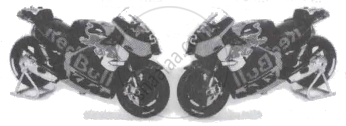Advertisements
Advertisements
प्रश्न
Show that lines:
`vecr=hati+hatj+hatk+lambda(hati-hat+hatk)`
`vecr=4hatj+2hatk+mu(2hati-hatj+3hatk)` are coplanar
Also, find the equation of the plane containing these lines.
उत्तर
`vecr=hati+hatj+hatk+lambda(hati-hat+hatk) .......(i)`
Convert ing into cartesian form,
`(x-1)/1=(y-1)/-1=(z-1)/1`
(x1,y1,z1)=(1,1,1)
a1=1,b1=-1,c1=1
`vecr=4hatj+2hatk+mu(2hati-hatj+3hatk)......(ii)`
Convert ing into cartesian form,
(x2,y2,z2)=(0,4,2)
a2=2,b2=-1,c2=3
Condition for the lines to be coplanar is
`|[0-1,4-1,2-1],[1,-1,1],[2,-1,3]|=|[-1,3,1],[1,-1,1],[2,-1,3]|=0`
the lines are coplanar
Intersection of the two lines is
Let the equation be a(x-x1 )+b(y -y1 )+ c(z - z1 )= 0.....(iii)
Direction ratios of the plane is
a-b+c=0
2a-b+3c=0
Solving by cross-multiplication
`a/(-3+1)=b/(2-3)=c/(-1+2)`
Since the plane passes through (0,4,2) from line (ii)
a(x-0)+b(y-4)+c(z-2)=0
`=>-2lambdax-lambda(y-4)+lambda(z-2)=0`
`=>-2x-y+4+z-2=0`
`=>-2x-y+z=-2`
`=>2x+y-z=2`
APPEARS IN
संबंधित प्रश्न
Find the shortest distance between the lines
`bar r = (4 hat i - hat j) + lambda(hat i + 2 hat j - 3 hat k)`
and
`bar r = (hat i - hat j + 2 hat k) + mu(hat i + 4 hat j -5 hat k)`
where λ and μ are parameters
Find the shortest distance between the lines.
`(x + 1)/7 = (y + 1)/(- 6) = (z + 1)/1` and `(x - 3)/1 = (y - 5)/(- 2) = (z - 7)/1`.
Find the shortest distance between the lines whose vector equations are `vecr = (1-t)hati + (t - 2)hatj + (3 -2t)hatk` and `vecr = (s+1)hati + (2s + 1)hatk`.
Find the shortest distance between lines `vecr = 6hati + 2hatj + 2hatk + lambda(hati - 2hatj + 2hatk)` and `vecr =-4hati - hatk + mu(3hati - 2hatj - 2hatk)`.
Find the shortest distance between the lines `(x+1)/7=(y+1)/(-6)=(z+1)/1 and (x-3)/1=(y-5)/(-2)=(z-7)/1`
Find the shortest distance between the lines `vecr = (4hati - hatj) + lambda(hati+2hatj-3hatk)` and `vecr = (hati - hatj + 2hatk) + mu(2hati + 4hatj - 5hatk)`
Find the shortest distance between the lines
Find the shortest distance between the lines
|
The fuel cost per hour for running a train is proportional to the square of the speed it generates in km per hour. If the fuel costs ₹ 48 per hour at a speed of 16 km per hour and the fixed charges to run the train amount to ₹ 1200 per hour. Assume the speed of the train as v km/h. |
Given that the fuel cost per hour is k times the square of the speed the train generates in km/h, the value of k is:
|
The fuel cost per hour for running a train is proportional to the square of the speed it generates in km per hour. If the fuel costs ₹ 48 per hour at a speed of 16 km per hour and the fixed charges to run the train amount to ₹ 1200 per hour. Assume the speed of the train as v km/h. |
If the train has travelled a distance of 500 km, then the total cost of running the train is given by the function:
|
The fuel cost per hour for running a train is proportional to the square of the speed it generates in km per hour. If the fuel costs ₹ 48 per hour at a speed of 16 km per hour and the fixed charges to run the train amount to ₹ 1200 per hour. Assume the speed of the train as v km/h. |
The fuel cost for the train to travel 500 km at the most economical speed is:
Find the shortest distance between the following lines:
`vecr = (hati + hatj - hatk) + s(2hati + hatj + hatk)`
`vecr = (hati + hatj - 2hatk) + t(4hati + 2hatj + 2hatk)`
Find the equation of line which passes through the point (1, 2, 3) and is parallel to the vector `3hati + 2hatj - 2hatk`
Distance between the planes :-
`2x + 3y + 4z = 4` and `4x + 6y + 8z = 12` is
The planes `2x - y + 4z` = 5 and `5x - 2.5y + 10z` = 6
Find the shortest distance between the lines, `vecr = 6hati + 2hatj + 2hatk + lambda(hati - 2hatj + 2hatk)` and `vecr = - 4hati - hatk + mu(3hati - 2hatj - 2hatk)`
Read the following passage and answer the questions given below.
|
Two motorcycles A and B are running at the speed more than the allowed speed on the roads represented by the lines `vecr = λ(hati + 2hatj - hatk)` and `vecr = (3hati + 3hatj) + μ(2hati + hatj + hatk)` respectively.
|
Based on the above information, answer the following questions:
- Find the shortest distance between the given lines.
- Find the point at which the motorcycles may collide.
The shortest distance between the line y = x and the curve y2 = x – 2 is ______.
The largest value of a, for which the perpendicular distance of the plane containing the lines `vec"r" = (hat"i" + hat"j") + λ(hat"i" + "a"hat"j" - hat"k")` and `vec"r" = (hat"i" + hat"j") + μ(-hat"i" + hat"j" - "a"hat"k")` from the point (2, 1, 4) is `sqrt(3)`, is ______.
The shortest distance between the z-axis and the line x + y + 2z – 3 = 0 = 2x + 3y + 4z – 4, is ______.
Find the distance between the lines:
`vecr = (hati + 2hatj - 4hatk) + λ(2hati + 3hatj + 6hatk)`;
`vecr = (3hati + 3hatj - 5hatk) + μ(4hati + 6hatj + 12hatk)`
Show that the line whose vector equation is `vecr = (2hati - 2hatj + 3hatk) + λ(hati - hatj + 4hatk)` is parallel to the plane whose vector equation is `vecr.(hati + 5hatj + hatk) = 5`. Also find the distance between them.


